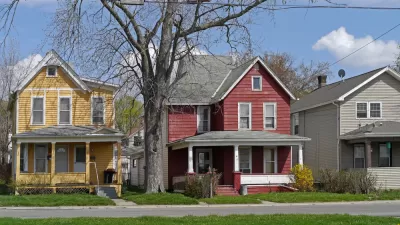Sixty years after Brown v. Board, exclusionary zoning and school district rules still promote the economic and racial segregation of public schools.

The link between public school educational performance and wealth may seem economically rational, but its often logically circuitous. Homebuyers are willing to pay more for housing in a high-performing school district. The demand for a high-performing school district raises the value of all real estate in the district, thereby reducing the affordable housing supply and limiting access to good schools to those who can pay a premium. However, Daniel Hertz warns that the resulting concentration of wealth and educational performance is not purely based on market-based forces. "If you scratch a housing issue, you’re likely to find a zoning issue."
Hertz cites a study by Jonathan Rothwell of the Brookings Foundation, which finds that zoning laws make a big difference. Laws that prevent high-density housing and/or subsidize large, luxury housing developments exacerbate the academic achievement gap between the wealthy and the poor. "The home price differential between high-scoring schools and low-scoring schools is 40 to 63 percentage points greater in metropolitan areas with the most restrictive zoning, compared to those with the least restrictive zoning, reports Daniel Hertz. “[Less restrictive zoning] shaves tens of thousands of dollars off the average price of housing near high-scoring schools."
Exclusionary schooling isn't only characterized by exclusionary zoning. Nikole Hannah-Jones finds that communities intervene to prevent racial integration. In a two-part story on This American Life, Hannah-Jones describes the controversy that ensued when an accidental experiment in school integration occurred in the St Louis region.
The predominantly black and low-income Normandy school district (the school district of Michael Brown) lost accreditation in 2013, setting into effect the “transfer law,” which allowed students of the district to freely transfer to any other district. The law also requires that the poorly performing district designate one official transfer district and effectively subsidize it for every student that chooses to transfer. Normandy chose the Francis Howell School District - a wealthy, white-majority district more than 30 miles away on the highway. That 1,000 students - 25 percent of the Normandy district- chose to defy the district's expectations and get up at 5am every morning to take the bus to faraway schools attests to the dire conditions of the Normandy school system and the high demand by parents and students for better academic outcomes.
Within weeks of the transfer law going into effect, the white, wealthy parents of Francis Howell turned out in force to show their opposition to the influx of low-income, black students. Normandy did not lose its accreditation because of violence, but the parents of Francis Howell repeatedly claimed violence as a primary concern. At a crowded town hall meeting, they demanded metal detectors, made threats to move out of the district and made suggestions such as making class times earlier to discourage Normandy commuters from showing up.
Despite the parents' expectations, Hannah-Jones found that a year after the transfer law went into effect, it was working. “None of the things that [Francis Howell] parents were worried about came true. No one got stabbed, test scores didn't drop at all, and at least so far, the influx of black students hasn't caused white parents to flee...Where the transfer law forced integration, it's working.”
Ultimately, permission to freely transfer out of Normandy was rescinded the following year. The state took over the school and required students to obtain a court-ordered injunction to enroll at a Francis Howell school. Not surprisingly, most students returned to the re-branded but still poor-performing Normandy district.
Hertz and Hannah-Jones do not argue that promoting equality is simply about removing restrictions on development and school districts. Hannah-Jones says there are longitudinal data that show court-ordered integration improves outcomes for under-achieving minority students.
Integration gets black kids in the same facilities as white kids, and therefore it gets them access to the same things those kids get.”
Likewise, Hertz feels that a laissez-faire housing market is not the best prescription. He writes for the Washington Post:
To be clear, even zoning reform’s most high-profile advocates don’t limit themselves to calling for fewer restrictions on private development. Even the Harvard economist Ed Glaeser, who could fairly be called a free-market sympathizer, has written that the market will never provide enough affordable housing on its own, and suggested massively expanding housing subsidies for low-income residents.”
FULL STORY: Zoning in everything—even the education gap

Maui's Vacation Rental Debate Turns Ugly
Verbal attacks, misinformation campaigns and fistfights plague a high-stakes debate to convert thousands of vacation rentals into long-term housing.

Planetizen Federal Action Tracker
A weekly monitor of how Trump’s orders and actions are impacting planners and planning in America.

Chicago’s Ghost Rails
Just beneath the surface of the modern city lie the remnants of its expansive early 20th-century streetcar system.

Bend, Oregon Zoning Reforms Prioritize Small-Scale Housing
The city altered its zoning code to allow multi-family housing and eliminated parking mandates citywide.

Amtrak Cutting Jobs, Funding to High-Speed Rail
The agency plans to cut 10 percent of its workforce and has confirmed it will not fund new high-speed rail projects.

LA Denies Basic Services to Unhoused Residents
The city has repeatedly failed to respond to requests for trash pickup at encampment sites, and eliminated a program that provided mobile showers and toilets.
Urban Design for Planners 1: Software Tools
This six-course series explores essential urban design concepts using open source software and equips planners with the tools they need to participate fully in the urban design process.
Planning for Universal Design
Learn the tools for implementing Universal Design in planning regulations.
planning NEXT
Appalachian Highlands Housing Partners
Mpact (founded as Rail~Volution)
City of Camden Redevelopment Agency
City of Astoria
City of Portland
City of Laramie




























